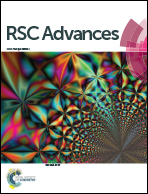Ultrasensitive and stable determination of lead ions by a glassy carbon electrode modified with a phenanthroline-based electropolymerized film†
Abstract
A novel electro-active compound, 3,8-bis(9,9-bis(6-(9H-carbazol-9-yl)hexyl)-9H-fluoren-2-yl)-1,10-phenanthroline (TCFC), is used to modify a glassy carbon electrode (GCE) for the electrochemical detection of Pb2+. The phenanthroline unit in the backbone and four electro-active alkyl-linked peripheral carbazole groups as the side chains endow TCFC with metal-chelating ability and the possibility of electropolymerization. By the method of chemical preconcentration/absorption square wave anodic stripping voltammetry (SWASV), the TCFC electropolymerized film-modified GCE (TCFC/GCE) shows excellent selectivity and sensitivity towards Pb2+, even in the presence of a large amount of other heavy metal ions (HMIs). The calculated limit of detection (LOD) towards Pb2+ could be improved to 1.33 × 10−11 M (S/N = 3) under optimum conditions. Moreover, TCFC/GCE is stable under ambient conditions (>30 days) and can be recycled while retaining high sensitivity, which is of great practical value. Further, TCFC/GCE can be applied to the determination of Pb2+ in real water samples.


 Please wait while we load your content...
Please wait while we load your content...